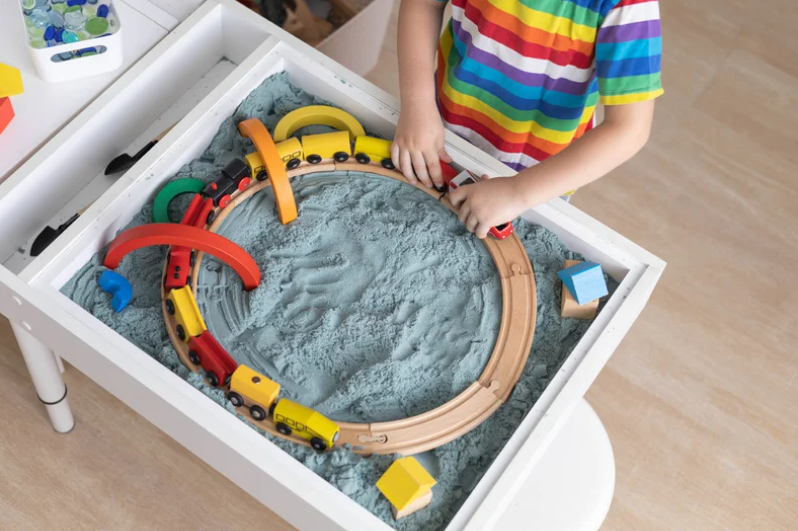Home Study Play Therapy Training

Play Therapy Book Study – Continuing Education (CE) Credits
APT Approved Provider 15-439
CFCE offers you the opportunity to earn continuing education (CE) credit by completing book tests* based on play therapy publications!
*The fee below only includes CE test. The book must be purchased separately.
APT CE credits will be awarded to mental health professionals -or- full-time graduate students in a mental health field that achieve an 85% pass rate on this assessment, within no more than three attempts.
Your CE certificate will be issued within one week of the submission of your passing score and completed evaluation of the program.

Available Assessments:

“Windows to Our Children”
by Violet Oaklander
Eligible for 11 APT Non-contact CE credits
Fee: $110 (assessment only)
Learning Objectives:
- Understand the foundational principles of Gestalt therapy as applied to children, as outlined by Violet Oaklander in “Windows to Our Children“.
- Describe the significance of the therapeutic relationship in Gestalt therapy with children, as elucidated by Oaklander, and analyze its role in facilitating emotional growth and healing.
- Examine the concept of “windows” as metaphors for exploring children’s inner experiences and emotional worlds, and discuss how these windows manifest in therapy sessions.
- Describe at least 4 of Oaklander’s projective techniques used to foster self-awareness, self-expression, and emotional integration in children.
- Discuss the role of creativity and imagination in Gestalt therapy with children, and analyze how Oaklander utilizes these elements to engage with and support young clients.
- Explain how Oaklander uses games in therapy with children.
- Describe Oaklander’s approach to working with resistance in children, and discuss strategies for creating a safe therapeutic environment conducive to exploration and growth.
- Explain how Oaklander structures therapeutic sessions for children and their families.
Book Description:
Windows to Our Children is a seminal work in the field of Gestalt therapy, specifically focusing on children and adolescents. Published in 1978 and revised in later editions, the book outlines Oaklander’s innovative approach to therapeutic practice with young people. At its core, Oaklander’s approach integrates principles of Gestalt therapy with play therapy techniques, emphasizing the importance of creative expression and the therapeutic relationship in facilitating healing and growth in children. The book provides practical insights and techniques for therapists, educators, and parents alike, offering a framework for understanding and addressing issues such as anxiety, trauma, behavioral challenges, and emotional regulation in children. Oaklander’s approach encourages therapists to engage authentically with children, using play, art, and metaphorical language to explore and resolve underlying issues. This book remains a foundational text in child therapy, renowned for its compassionate approach and enduring relevance in helping children and adolescents achieve emotional well-being and personal growth.

“Hidden Treasure: A Map to the Child’s Inner Self (1st Ed.)”
by Violet Oaklander
Eligible for 6 APT Non-contact CE credits
Fee: $60 (assessment only)
Learning Objectives:
- Identify foundational principles of Gestalt Play Therapy
- List the steps of the therapeutic process in working with children and adolescents in Gestalt Play Therapy
- Describe the importance of contact in Gestalt Play Therapy and the ways that contact is disturbed
- Discuss the Oaklander method for working with aggressive energy
- Describe at least 4 expressive activities used with children and adolescents according to the Oaklander model.
- Discuss the use of the Oaklander model with the specific populations of groups, young children, adolescents, children with grief and loss, and children with ADHD.
Book Description:
Hidden Treasure is a follow up to Oaklander’s first book, Windows To Our Children. Most of the books available in working with this population are written from a traditional ‘play therapy’ point of view. The Gestalt Therapy-based approach provides a more effective method for psychotherapeutic work with children of all ages. The focus is on the relationship between the therapist and client, rather than observation and interpretation. It is a vigorous, dynamic approach.Violet Oaklander uses a wide variety of creative, expressive and projective techniques in her work, and each chapter reflects and exemplifies the use of this work in the service of therapy. The approach is applicable to a wide variety of ages, as well as individual, family and group settings. The book will interest child and adolescent psychotherapists, psychologists, social workers, counselors, interns, school personnel as well as graduate-level students. Parents may also find it helpful, as well as adults who are interested in the child within.

“Healing Through Play Using the Oaklander Model:
A Guidebook for Therapists and Counselors Working with Children, Adolescents and Families (1st Ed.)”
by Karen Fried
Eligible for 2 APT Non-contact CE credits
Fee: $20 (assessment only)
Learning Objectives:
- Describe the specific components of Violet Oaklander’s model of Gestalt play therapy.
- Describe at least four Gestalt Play Therapy interventions.
Book Description:
This guidebook was created to serve as a companion to the Oaklander Training Program that Violet developed after publishing Windows to Our Children. Child and adolescent therapists came from all over the world to attend her life-changing two-week intensive workshops in Santa Barbara, California. This training continues in Santa Monica, California (led by Karen Fried) and in other United States and international venues by facilitators whom Violet trained, including Lynn Stadler and Peter Mortola. While this guidebook is meant to be used by therapists who have participated in Violet’s training process, that experience is not a requirement. Here, they outline Violet’s thinking as well as some of her classic experiential exercises for you to use when a child or adolescent comes to therapy. Introduction to the model includes how to conduct a first session and how to take developmental factors into account. The guide then explains key elements of Violet’s signature focus on a young client’s ability to contact (inwardly and outwardly), and details how you can enable youngsters at any developmental stage to develop healthy contact functions and to strengthen their sense of self. In addition, this guidebook outlines Violet’s approach to the emotions-including the universal but often-misunderstood ones of anger and aggressive energy that can be challenging to handle in a therapy session. To support you in doing so, the guidebook leads you, step by step, through many of her most effective projective techniques, such as the Safe Place and Rosebush drawings and working with clay, sand tray, and puppets. Finally, it lays out the self-nurturing process, often arising at the end of therapy, and explicates Violet’s insights on developmental issues impacting termination for you to apply in your own practice.

“Aggression in Play Therapy:
A Neurobiological Approach for Integrating Intensity (1st Ed.)”
by Lisa Dion
Eligible for 5 APT Non-contact CE credits
Fee: $50 (assessment only)
Learning Objectives:
- Recognize the importance and therapeutic value of aggressive play
- Identify at least 3 strategies for staying regulated while working with aggression in the playroom
- Define “emotional flooding”
- Examine the concept of “The Setup” in the playroom as a way to understand what the child is trying to communicate
- Explain the significance of authentic expression from the therapist in the play therapy process
Book Description:
With an understanding of aggressive play based on brain function and neuroscience, this book provides therapists with a framework to work authentically with aggressive play, while making it an integrative and therapeutic experience for the child. Through the lens of neuroscience and interpersonal neurobiology, therapists are taught how to integrate the intensity experienced by both the child and the therapist during aggressive play in a way that leads towards greater healing and integration. The book explains the neurological processes that lead kids to dysregulation and provides therapists with tools to help their clients facilitate deep emotional healing, without causing their own nervous system to shut down. Topics covered include: embracing aggression; understanding the nervous system; understanding regulation; developing yourself as an external regulator; authentic expression; setting boundaries; working with emotional flooding; supporting parents during aggressive play.

“Sandtray Therapy: A Practical Manual (4th Ed.)”
by Linda E. Homeyer and Daniel S. Sweeney
Eligible for 5 APT Non-contact CE credits
Fee: $50 (assessment only)
Learning Objectives:
- Describe how to set up a sandtray therapy room with a sand tray and specific categories of miniatures.
- List a six-step protocol for conducting a sandtray session.
- Explain at least two ways to process the sandtray session with a client.
- Discuss at least 4 different therapeutic approaches that can be integrated with sandtray therapy.
- List at least 3 reasons why sandtray therapy can be beneficial for clients with trauma.
- Describe at least 2 interventions with sandtray therapy that can be used with couples and/or families.
Book Description:
Sandtray Therapy is an essential book for professionals and students interested in incorporating this unique modality into work with clients of all ages. The fourth edition includes important discussion of the neurobiological aspects of trauma and sandtray therapy, further exploration of sandtray therapy in the context of the DSM-5, and a renewed review of the sandtray therapy literature. Readers will find that the book is still replete with handouts, images, examples, and resources. The authors’ six-step protocol guides beginners through a typical session, including room setup, creation and processing of the sandtray, cleanup, post-session documentation, and much more.

“Advanced Play Therapy:
Essential Conditions, Knowledge, and Skills for Child Practice (1st Ed.)”
by Dee Ray
Eligible for 8 APT Non-contact CE credits
Fee: $80 (assessment only)
Learning Objectives:
- Identify two key historical figures in play therapy and their contributions to the field.
- Explain the developmental rationale of utilizing play therapy with children.
- List three questions to ask when considering toy and play material selection.
- Demonstrate three verbal response skills.
- Describe the difference between play themes and play behaviors.
- Examine common beliefs of play therapists.
- List two benefits of group play therapy.
- Determine appropriate considerations for termination in play therapy.
Book Description:
Current play therapy resources offer details on how to conduct play therapy, but are limited in addressing the challenges that develop when therapists conduct play therapy with real-life clients. Using the Child-Centered Play Therapy Approach, Ray has written the first book to address these complex play therapy subjects. Topics covered include: integrating field knowledge of play, development, and theory into the advanced play therapist’s knowledge base; working with difficult situations, such as limit-setting, aggression, and parents; addressing modern work concerns like measuring progress, data accountability, and treatment planning; differentiating play therapy practice in school and community settings; and addressing complicated skills, such as theme work, group play therapy, and supervision. Ray also includes her Child Centered Play Therapy Treatment Manual, an invaluable tool for any play therapist accountable for evidence-based practice. This manual can also be found on the accompanying downloadable resources, along with treatment plan, session summary, and progress-tracking worksheets.

“Play Therapy (4th Ed.)”
by Garry Landreith
Eligible for 11 APT Non-contact CE credits
Fee: $110 (assessment only)
Learning Objectives:
- Discuss the development and history of play therapy.
- Explain the function of play within the therapeutic process.
- Identify key concepts and principles of Child-Centered Play Therapy (CCPT).
- Categorize types of facilitative therapeutic responses provided in play therapy.
- List the seven principles that rationalize the use of therapeutic limit setting.
- Assess the therapeutic intention of playroom logistics and material selection.
- Describe personality characteristics of the play therapist that are conducive to the play therapy process.
- Evaluate therapeutic progress and indicators for termination within play therapy.
Book Description:
This book details Child-Centered Play Therapy (CCPT), an evidence-based model, which stresses the importance of understanding the child’s world. Professors who have taught a course based on the previous editions will be pleased to find the core message intact but updated with a comprehensive review of rigorous contemporary research demonstrating the strong evidence base for CCPT across cultural groups and presenting issues. Expanded to cover additional topics of interest, this new edition includes a model of the change process in CCPT and 13 new Rules of Thumb that help clarify the CCPT relationship, and discusses deeper issues in CCPT, such as recognizing emotional blocks in play therapy, being culturally responsive, discovering meaning when there seems to be no meaning, and more.

“The Guide to Play Therapy Documentation and Parent Consultation”
by Linda Homeyer and Mary Morrison Bennet
Eligible for 4 APT Non-contact CE credits
Fee: $40 (assessment only)
Learning Objectives:
- Explain the Golden Thread metaphor as it relates to the importance of clinical play therapy documentation and parent consultation.
- Discuss the process of beginning play therapy with a client from the initial inquiry through the initial parent consultation session.
- Identify the steps to developing a treatment plan and give examples based on at least two different treatment models.
- List the essential components of a play therapy session note.
- Discuss the skills required to conduct effective parent consultations including dealing with difficult topics and situations.

To be added to our email list for notifications of training dates, complete our Interested in Play Therapy Training form.